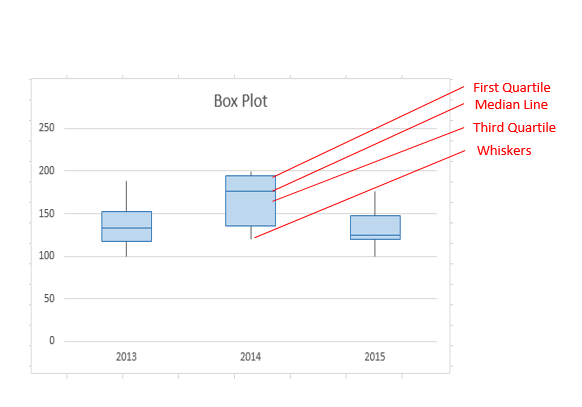
- #Interpreting a box and whisker plot how to
- #Interpreting a box and whisker plot full
- #Interpreting a box and whisker plot code
On the other hand, if our data contains values of odd numbers, so the 1 st median was an actual data point, then we do not include that value in our sub-median calculations. Mathematically, if our data contains values of an even number, thereby the 1 st median was the average of the 2 middle values, and then we include the middle values in the sub-median calculations. In order to split the data into quarters, we then determine the medians of these two halves. The purpose of finding the median is that it splits the data into two halves. Order our data (i.e., putting the values) in numerical order, if they aren't ordered already. We also refer it to as a whisker plot when the lines stretching out from the boxes specify variability on the exterior of the upper and lower quartiles.įor the purpose of creating a box-and-whisker plot, we follow the below given steps: The "box" in the box-and-whisker plot consists of, and thus highlights, the centre most of these data points.Īnd when we represent the data distribution in a standardized format using 5 summary – minimum, Q 1 (1 st Quartile), median, Q 3 (3 rd Quartile), and maximum, it is known as the Box plot. That is to say, it is believed that there is an " average" of some sort. the numbers in your list) are bundled around some central value. It is worth to mention that you can create a boxplot from the variable you have just created ( res) with the bxp function.For many statistical calculations, it is conjectured that the data points (i.e.
#Interpreting a box and whisker plot code
You can follow the code block to add the lines and points for horizontal and vertical box and whiskers diagrams. In order to calculate the mean for each group you can use the apply function by columns or the colMeans function. In this case, you can make use of the lapply function to avoid for loops. You can also add the mean point to boxplot by group. You can change the mean function of the previous code for other function to display other measures. # abline(v = mean(x), col = 2, lwd = 2) # Entire line # abline(h = mean(x), col = 2, lwd = 2) # Entire line
#Interpreting a box and whisker plot how to
In the following code block we show you how to add mean points and segments to both type of boxplots when working with a single boxplot. Note that the code is slightly different if you create a vertical boxplot or a horizontal boxplot. For that purpose, you can use the segments function if you want to display a line as the median, or the points function to just add points. Nevertheless, you may also like to display the mean or other characteristic of the data. Legend("topright", legend = "Boxplot", # Position and titleįill = rgb(1, 0, 0, alpha = 0.4), # Colorīy default, when you create a boxplot the median is displayed. Main = "Customized boxplot in base R", # Title Horizontal = FALSE, # Horizontal or vertical plot Grid(nx = NULL, ny = NULL, col = "white", lty = 1,

#Interpreting a box and whisker plot full
Review the full list of graphical boxplot parameters in the pars argument of help(bxp) or ?bxp. Note that there are even more arguments than the ones in the following example to customize the boxplot, like boxlty, boxlwd, medlty or staplelwd. In the following block of code we show a wide example of how to customize an R box plot and how to add a grid.

# Boxplot from the R trees datasetīoxplot(trees, col = rainbow(ncol(trees)))īoxplot(stacked_df$values ~ stacked_df$ind,Ī boxplot can be fully customized for a nice result. Thus, each boxplot will have a different color. Note that you can change the boxplot color by group with a vector of colors as parameters of the col argument. Now, you can plot the boxplot with the original or the stacked dataframe as we did in the previous section.

Nevertheless, you can convert this dataset as one of the same format as the chickwts dataset with the stack function. Note the difference respect to the chickwts dataset. For illustration purposes we are going to use the trees dataset. In case all variables of your dataset are numeric variables, you can directly create a boxplot from a dataframe.



 0 kommentar(er)
0 kommentar(er)
